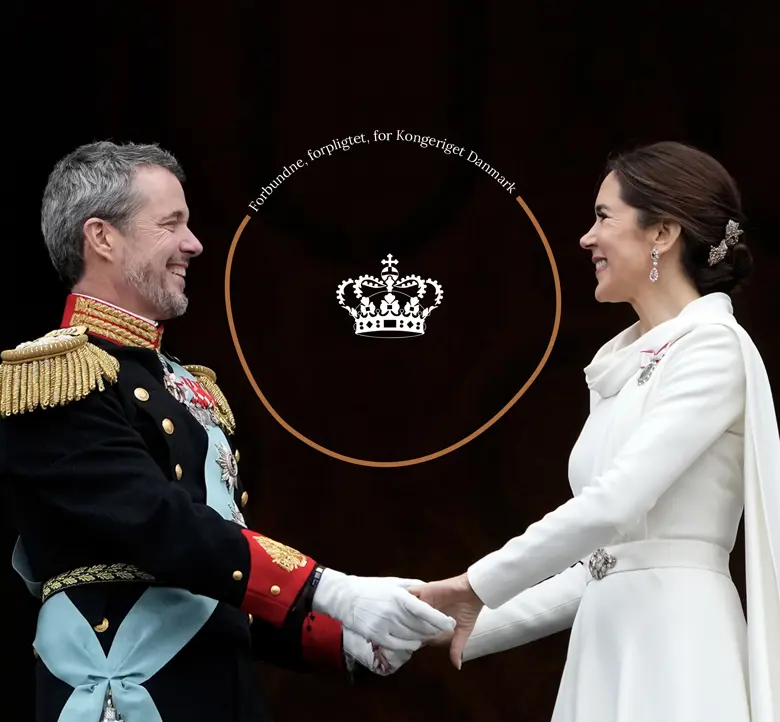Crown Jewels and Danish Royal Property Trust Jewellery
For special events such as state visits, New Year’s banquets and other large functions for which gala clothing and items are worn, the female members of The Royal Family usually put historic jewellery to use. Often as a set, also called garnitures, with a tiara and earrings, necklace and possibly a bracelet. The jewels are partly crown jewels, partly jewellery owned by The Danish Royal Property Trust as well as jewellery owned privately by The Royal House of Denmark.

The Crown Jewels
The best-known jewels are the crown jewels, which primarily consist of four large jewellery sets: a brilliant-cut diamond set, an emerald set, a pearl-ruby set and a rose-cut diamond set. The crown jewels belong to the Crown, i.e. the monarch and his queen. After the succession of the throne, they will be at the disposal of HM Queen Mary. When the crown jewels are not in use, they are displayed in the treasury in the secured cellar under Rosenborg Castle.
By custom, the crown jewels remain in Denmark, which means that they are not carried along during visits abroad. The Danish crown jewels are the only ones in the world that are both exhibited as museum objects and, at the same time worn, by the country’s queen.
The history of the crown jewels goes back to Christian VI’s queen, Queen Sophie Magdalene, who, in her will from 1746, stipulated that her jewellery should not be passed to one specific person but should always be at the disposal of the country’s sitting queen, with the justification that “in this Royal House, there are so few jewels and no crown jewels at all". Most of Queen Sophie Magdalene’s original jewellery has been modified by subsequent queens as jewellery fashions have changed. Today, the four crown jewel sets are in the form that Christian VIII’s queen, Queen Caroline Amalie, gave them in 1840.
The Jewellery in The Danish Royal Property Trust
Another group of distinctive jewels is the jewellery from The Danish Royal Property Trust. These pieces of jewellery include, among others, the Pearl Poire set, with tiara, necklace, earrings and brooches, the large brilliant-cut diamond necklace, called the Rivière, and the brilliant diamond frame with royal portrait worn by The Queen at gala events.
The Danish Royal Property Trust was established by Frederik VIII and Queen Lovisa in 1910. The purpose was to collect and secure gold, silver and other valuable objects “which are desired to be kept in Our Family and therefore shall pass undivided from King to King of our House”.
The objects in a type of trust called a fideicommissum are passed down from generation to generation. They are not owned by the individual person, and a sale or pledging of the inheritance is therefore not possible. In the Danish Royal Property Trust, this means that important collections – not least co-founder Queen Lovisa’s large inheritance from her Dutch, German, French and Swedish ancestors – have been able to be kept together in The Royal House of Denmark.
Jewellery from The Danish Royal Property Trust is used by the sitting queen and can be taken abroad to be used at gala events.
The Royal House of Denmark’s private jewellery
The Queen and the other women in The Royal Family also have a collection of privately-owned jewellery that they have at their own disposal.
In Queen Margrethe’s collection, one can find, among other things, the palmette tiara and the sapphire set with necklace and earrings which Frederik IX had made as wedding gifts for his daughter, heir to the throne Princess Margrethe. Other important jewels are the ruby and pearl set, which was a silver wedding anniversary gift from Prince Henrik, and the Greenlandic gold tiara, the flower tiara Naasut – a gift from Greenland in connection with the 40th anniversary of The Queen’s reign in 2012.
In the future Queen Mary’s jewel collection, one can find the old Russian turquoise and brilliant-cut diamond jewellery that Queen Margrethe gave to her daughter-in-law for her 50th birthday in 2022, and a delicate brilliant diamond tiara, which can also be used as a necklace, and which the future queen herself has purchased at auction.
Best known among the privately-owned jewels the future queen wears is likely the ruby set given to the future king by his grandmother, Queen Ingrid. The set was made for French marshal Jean-Baptiste Bernadotte’s wife, Desirée, and was worn at Emperor Napoleon’s coronation in 1804. The set came to Sweden via the Bernadotte couple when they were appointed the Crown Prince Couple of Sweden. Desirée, who became Queen Desideria of Sweden in 1818, then passed it on to her daughter-in-law Josefina. As Queen Dowager, Josefina, in 1869, gave the set to her grandchild, Princess Lovisa, for her wedding with Danish Crown Prince Frederik (VIII) with the explanation “the Danish colours for Lovisa”.





